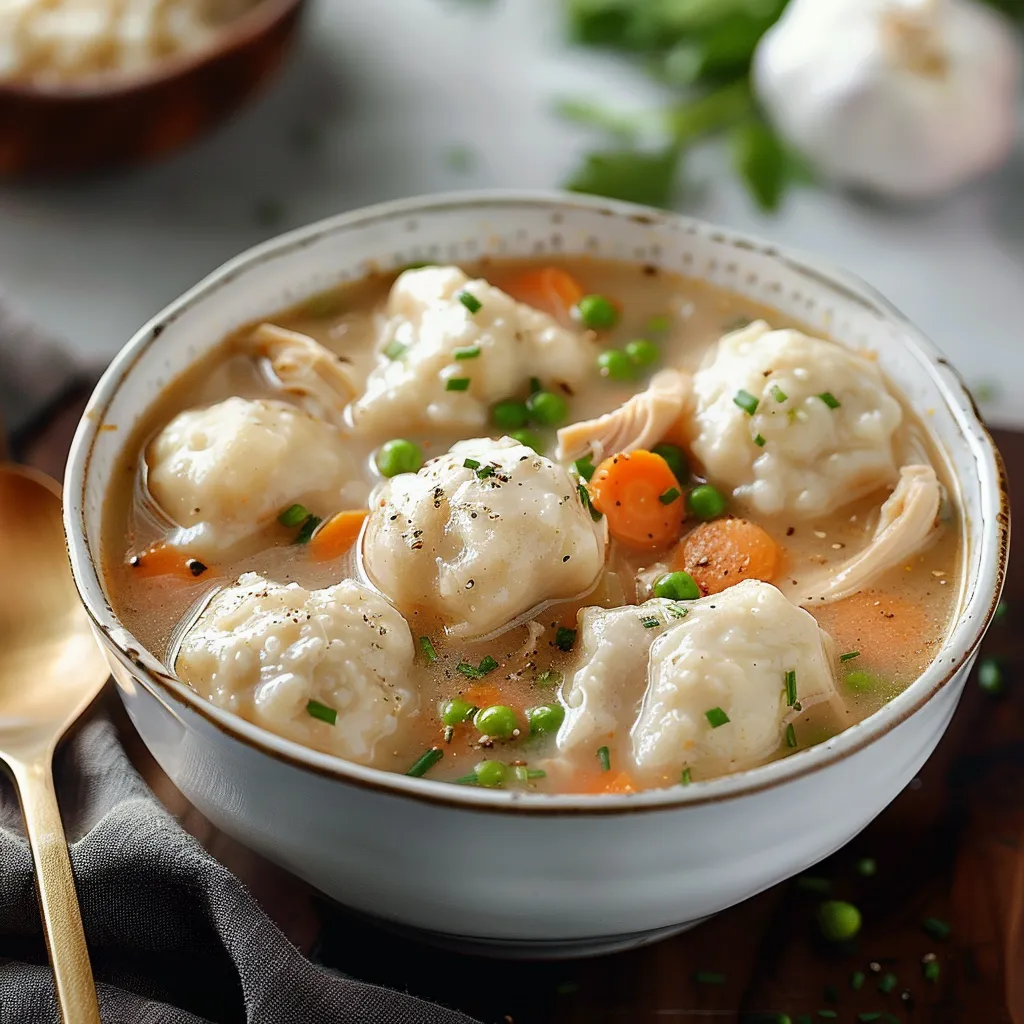 Pin it
Pin it
This homemade chicken and dumpling soup has been my family's ultimate comfort food during cold winter months. The fluffy dumplings float in a creamy broth alongside tender chicken, creating a heartwarming meal that feels like a hug in a bowl.
I first made this recipe during a particularly brutal winter storm when we were snowed in for days. The aroma filled our home with warmth, and it has since become the most requested meal whenever temperatures drop below freezing.
Ingredients
- Boneless skinless chicken breasts: Provide lean protein and shred beautifully in the soup. Look for plump pieces without discoloration.
- Butter: Creates richness in both the soup base and dumplings. Use salted for extra flavor.
- Sweet onion, carrots, and celery: Form the aromatic base. Choose firm vegetables with vibrant color.
- Garlic: Adds depth and complexity. Fresh cloves deliver the best flavor.
- All purpose flour: Thickens both the broth and creates pillowy dumplings.
- Chicken broth: Forms the foundation. Use low sodium to control saltiness.
- Better Than Bouillon concentrate: Intensifies the chicken flavor without additional liquid.
- Dried herbs (thyme, rosemary, basil, tarragon, and sage): Create complexity with minimal effort.
- Whole milk and sour cream: Add creaminess and richness to both broth and dumplings.
- Frozen peas: Provide bright color and sweet flavor. No need to thaw first.
- Baking powder and baking soda: Create perfectly fluffy dumplings that puff up as they cook.
Step-by-Step Instructions
- Sear the Chicken:
- Season chicken breasts generously with salt and pepper before searing in hot oil. Cook just until golden on both sides without worrying about cooking through completely. This step builds incredible flavor through browning reactions. Once cooled slightly, cut into bite sized pieces.
- Create the Flavor Base:
- Melt butter in the same pot to capture all those browned bits from the chicken. Add onions, carrots, and celery, cooking until they begin to soften but still maintain some texture. This mirepoix forms the foundation of flavor. Add garlic just at the end to prevent burning.
- Build the Broth:
- Sprinkle flour over the vegetables and stir continuously to prevent lumps. The gradual addition of broth creates a velvety texture. Add liquid in stages, stirring well between additions to ensure smoothness. This method prevents the dreaded flour lumps that can ruin texture.
- Develop Depth:
- Return the chicken to the pot along with herbs and bouillon. The bouillon concentrate adds remarkable depth that would otherwise require hours of simmering. Allow everything to simmer until chicken becomes tender enough to shred easily with a fork.
- Prepare Dumplings:
- Combine dry ingredients in a bowl before adding wet ingredients. The dough should be thick enough to hold its shape when dropped into the simmering soup. Avoid overmixing which can create tough dumplings.
- Cook Dumplings:
- Drop tablespoon sized portions of dumpling dough directly into the simmering broth. Ensure the dumplings are fully submerged for even cooking. Cover and cook until they puff up and a toothpick inserted comes out clean.
- Finish the Soup:
- Add milk and frozen peas at the very end. The milk brings creaminess while the peas maintain their bright color and fresh flavor. Gentle stirring prevents breaking the tender dumplings.
 Pin it
Pin it
My absolute favorite part of this recipe is watching the dumplings transform from sticky dough to fluffy pillows. My grandmother taught me this recipe when I was just learning to cook, and she always insisted on using whole milk for richness rather than skimming with lower fat options.
Make-Ahead Tips
This soup can be partially prepared in advance to make weeknight dinners easier. Complete all steps through simmering the broth, then refrigerate. When ready to serve, reheat the soup to simmering before adding the dumpling dough. Fresh dumplings always have the best texture compared to storing them already cooked.
Perfect Substitutions
While chicken breasts work beautifully, boneless skinless thighs create an even richer flavor profile. For a dairy free version, substitute plant based milk and vegan butter. The soup can accommodate virtually any vegetables you have on hand. Try adding corn, green beans, or even spinach for variety.
Serving Suggestions
Serve this hearty soup in wide, shallow bowls to showcase the beautiful dumplings. A simple side salad with vinaigrette provides refreshing contrast to the richness. For special occasions, sprinkle fresh herbs like thyme or parsley over each serving for visual appeal and brightness.
 Pin it
Pin it
This comforting soup is the perfect antidote to chilly days and a guaranteed family favorite!
Frequently Asked Questions
- → Can I use chicken thighs instead of chicken breasts?
Yes, boneless skinless chicken thighs work perfectly as a substitute for chicken breasts in this soup. They may even add more flavor and remain more tender throughout cooking.
- → Why didn't my dumplings fluff up?
Dumplings won't properly rise without both baking powder and baking soda. Make sure these leavening agents are fresh and active, and don't overmix the dumpling batter which can prevent them from becoming fluffy.
- → Can I make this soup ahead of time?
You can make the soup base ahead of time, but for best results, prepare and add the dumplings just before serving. Reheated dumplings tend to become dense and may break apart.
- → How do I know when the dumplings are cooked?
Dumplings are done when they've puffed up and a toothpick inserted into the center comes out clean, typically after 5-7 minutes of simmering. They should look dry on top and feel firm yet tender.
- → Can I freeze leftover chicken dumpling soup?
While you can freeze the soup base, dumplings don't freeze well as they tend to disintegrate when thawed. For best results, freeze only the soup portion and make fresh dumplings when reheating.
- → What can I substitute for Better Than Bouillon?
You can substitute with chicken bouillon cubes, chicken stock concentrate, or additional chicken broth. If using broth as a replacement, you might want to add a bit more salt or herbs to compensate for the reduced flavor concentration.
